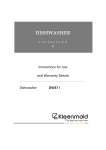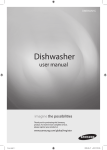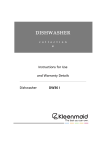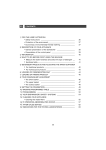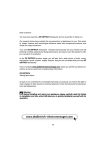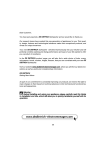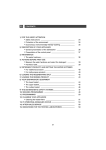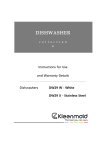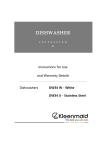Download DeDietrich Dishwasher User`s manual
Transcript
EN INSTRUCTIONS FOR USE Dishwasher Dear Customer, You have just acquired a DE DIETRICH dishwasher and we would like to thank you. Our research teams have created this new generation of appliances for you. Their quality, design, features and technological advances make them exceptional products, and reveal our unique know-how. Your new DE DIETRICH dishwasher will blend harmoniously into your kitchen and will perfectly combine washing and drying performance and ease of use. We wanted to offer you a product of excellence. In the DE DIETRICH product range, you will also find a wide choice of hobs, ovens, microwaves, hoods, cookers, fridges, freezers, that you can coordinate with your new DE DIETRICH dishwasher. Visit our website www.de-dietrich.com, where you will find our latest innovations as well as useful and complementary information. DE DIETRICH Setting New Values As part of our commitment to constantly improving our products, we reserve the right to make changes to them based on technical advances to their technical and functional features and appearance. Warning : Before installing and using your appliance, please carefully read this Guide to Installation and Use, which will allow you to quickly familiarise yourself with its operation. 2 EN CONTENTS 1 / FOR THE USER’S ATTENTION • Safety instructions ______________________________________ • Environmental protection ________________________________ • Economical, environmentally friendly washing ________________ 2 / DESCRIPTION OF YOUR APPLIANCE • General presentation of the dishwasher ____________________ • Control panel __________________________________________ 3 / INFORMATION ____________________________________________ 4 / WHAT TO DO BEFORE FIRST USING THE MACHINE • Measure the water hardness and select the type of detergent __ • Hardness table__________________________________________ 5 / WATER SOFTENER ADJUSTMENTS __________________________ 6 / ADJUSTING THE SETTINGS •“SET” setting __________________________________________ •“4/1” setting ____________________________________________ 7 / LOADING THE DETERGENT PRODUCTS ______________________ 8 / LOADING THE REGENERATING SALT ________________________ 9 / LOADING THE RINSING PRODUCT ____________________________ 10 / YOUR DISHWASHER’S EQUIPMENT • The lower basket ________________________________________ • The upper basket ________________________________________ • Cutlery drawers ________________________________________ 11 / WASHING PROGRAMMES __________________________________ 12 / PROGRAMMING __________________________________________ 13 / CLEANING YOUR APPLIANCE • Cleaning the waste filters ________________________________ 14 / YOUR DISHWASHER’S SAFETY SYSTEMS ____________________ 15 / IF OPERATING ABNORMALITIES OCCUR ____________________ 16 / INDICATIONS FOR THE TESTING LABORATORIES ____________ 17 / AFTER-SALES SERVICE ____________________________________ 3 4 5 5 6 7 8 9 9 10 11 11 12 13 14 15 16 17 18 20 22 24 25 30 32 EN 1 / FOR THE USER’S ATTENTION • Children’s safety Important : — This appliance is not intended for use by young children or infirm persons unless they have been adequately supervised by a responsible person to ensure that they can use the appliance safely. — This appliance must only be used by adults. Ensure that children do not touch it and do not use it as a toy. Ensure that they do not operate the appliance’s controls. — Keep young children away from the appliance when it is operating. — Detergents contain irritant and abrasive substances. These products can have caustic effects on the eyes, the mouth or the throat. They can be extremely dangerous if ingested. Avoid any contact with the skin and the eyes. Ensure that the appliance’s detergent container is empty at the end of the washing cycle. — Place detergents out of children’s reach and do not put any detergent in the machine until just before you start the washing programme. — The water in your dishwasher is not drinking water; this is why children must not go near the appliance when its door is open. — Do not allow children to play with or sit on the door when it is open, as the dishwasher could overturn. — Once you have unpacked your appliance, place the packaging out of children’s reach. — Keep all the packaging materials (e.g. plastic bags, polystyrene, etc.) out of children’s reach because they can be dangerous for children (ie. risk of suffocation). Keep this user’s manual with your appliance. If the appliance is sold or transferred to someone else, ensure that the manual is with it. Please take note of these instructions before installing and using your appliance. They have been drawn up for your own and other people’s safety. • SAFETY INSTRUCTIONS • Installation — When you receive your appliance, unpack it or have it unpacked immediately. Check that it has not suffered any damage during transport. Express any reservations in writing on the delivery note, of which you keep a copy. Never connect up a damaged machine. If your appliance is damaged, please contact your dealer. — Before proceeding to connect up your machine, please refer to the instructions in your Installation Guide. — Your dishwasher must be kept disconnected from the mains supply throughout the whole of the installation process. — The electrical connection details on your appliance’s description plate must comply with those for the mains supply. — The socket must still be accessible once your appliance has been installed. — Do not alter or attempt to alter the appliance’s characteristics. This could put you at risk. — If your installation has to be altered, only entrust the electrical and plumbing work to a qualified electrician or plumber respectively. — Your appliance is designed for normal domestic use. Do not use it for industrial or commercial purposes or for any other purpose than that for which it has been designed. — Your appliance is designed to be used for household and similar applications such as : • staff kitchenettes in shops, offices and other professional environments, • farmhouses, • use by guests at hotels, motels and other residential-type facilities, • bed and breakfast type facilities. — The dishwasher’s walls must not be pierced under any circumstances. • Use — This appliance is not intended for use by persons (including children) with reduced physical, sensory or mental capabilities, or lack of experience and knowledge, unless they have been given supervision or instruction concerning use of the appliance by a person responsible for their safety. — When machine is running, do not open door. This may provoke steam leakage or splattering of water. 4 EN 1 / FOR THE USER’S ATTENTION — Only use products specially designed for your dishwasher (water softening salt, detergent and rinsing products). — As far as possible, avoid opening the dishwasher’s door when it is operating, and in particular during the heating phases, because scalding steam may escape or you may be splashed with hot water. The machine is fitted with a safety system that immediately blocks the dishwasher’s operation if the door is opened. — Never use chemical solvents in your appliance because these could cause an explosion. — Always close your appliance’s door after loading or removing your items. — Do not lean or sit on your appliance’s door when it is open. — You are strongly advised to disconnect the machine after use and turn off the water supply. — Unplug your machine before carrying out any technical work on it. — Avoid placing your machine immediately next to a cooking or heating appliance to prevent any risk of heat damage; — Do not place any items in your machine, which are not certified as dishwasher safe. — If you have removed an item before the end of the washing programme, it is important to rinse it carefully to remove any residual washing products. — If your appliance breaks down, never attempt to repair it yourself. Any repairs made by non qualified personnel can cause significant damage or lack of control. — The machine complies with applicable safety regulations. Any repairs should be carried out by qualified technicians. Repairs or changes that do not conform may be dangerous for the users. In case of replacement, only use original parts. — If the machine malfunctions due to other causes than those mentioned in this booklet, disconnect the machine (remove the plug) or break the circuit concerned and contact after-sales service. • ENVIRONMENTAL PROTECTION This appliance’s packaging material is recyclable. Help recycle it and protect the environment by dropping it off in the municipal receptacles provided for this purpose. Your appliance also contains a great amount of recyclable material. It is marked with this label to indicate that in countries that are a members of the European Union the used appliances should not be mixed with other waste. This way, the appliance recycling organised by your manufacturer will be done under the best possible conditions, in compliance with European Directive 2002/96/EC on Waste Electrical and Electronic Equipment. Contact your town hall or your retailer for the used appliance collection points closest to your home. We thank you doing your part to protect the environment. • ECONOMICAL, ENVIRONMENTALLY FRIENDLY WASHING — Remove any food residue from your crockery (bones, pips, etc.) — Do not pre-wash your items by hand (useless waste of water). — Utilise your dishwasher’s capabilities to the full for an economical, environmentally friendly wash. — Always select a washing programme suitable for the crockery type and how dirty they are. — Avoid overdosing with detergent, regenerating salt and rinsing liquid. Follow the recommendations in this guide (pages 9-10-11) and the instructions on the product packs. — Ensure that the water softener is correctly set (see page 10). 5 EN 2 / DESCRIPTION OF YOUR APPLIANCE • GENERAL PRESENTATION OF THE DISHWASHER A B C D E G F H I J K L Fig. 01 A Cutlery drawers G Salt compartment B Upper basket H Main filter C Wash product dispenser I Lower basket D Anti-block guide wire J Rinse aid dispenser E Lower sprinkler arm K Reference plate (Ref. S.A.V.) F Waste filter L Control panel Advice : This user’s guide is applicable to several models. There may be some slight differences in the details and the equipment between your appliance and the descriptions provided here. 6 EN 2 / DESCRIPTION OF YOUR APPLIANCE • CONTROL PANEL (SOME MODELS ONLY) -------------------------------------------------------------- or -------------------------------------------------------------- Fig. 02a A B C D F E A On/ Off : Press this button to start up the dishwasher. F G Pilot lights : Salt : B Selection buttons : For choosing the programme (see page 20). For enabling multi-function product adjustment (see page 21). On: indicates the salt compartment is empty or almost empty. Rinse aid : On: indicates the rinse aid compartment is empty or almost empty. C Set, Delayed end : Changing the settings (see page 10 and 11). Adjusting the programme end time (see page 20). Multi-function products : On: this indicates the “4/1” function is activated (see page 9 and 11). The programmes are automatically adapted to multi-function products. D Programme selected indicator : High brightness : this indicates the programme has been selected. G START : Press this button to start up the programme. In case of error, hold down this button for a few seconds to cancel a selection or a programme that is already running. E Display : This shows the current time, the programme end time, the remaining programme time and the setting adjustments. For power saving purposes, this dishwasher automatically goes onto standby if it has not been activated for a certain period (except in time delay mode). All the pilot lights will switch off except the “START” button light and the light for the programme in progress, which will flash. To exit standby mode, simply press the “START” button. The dishwasher will then go into its previous status. Observations : A short beep confirms the button has been pressed (except the “On/Off” button). 7 EN 3 / INFORMATION Important : Important: For your dishwasher to provide excellent washing and drying results and leave no marks, you must correctly adjust it using the water softening system, which works with dishwasher salt. Never use normal washing-up liquid. • Scale, when rainwater filters into the soil, For ease of use and in certain water hardness conditions only (< 25°F), multi-purpose products can make the it takes in mineral salts, some of which are found in solid form and are commonly referred to as scale. Scale in the water reduces the detergent’s washing efficiency, causes deposits to form on the dishwasher itself and leaves white marks on the dishes. The more scale there is in the water, the “harder” the water is. use of regenerating salt and rinsing liquid unnecessary. • “Two-in-one” tablets contain detergents and rinsing liquid or an agent serving the function of the salt. • “Three-in-one” tablets contain detergents and rinsing liquid as well as an agent serving the function of the salt. • “Four-in-one” “Five-in-one” tablets... also contain additives to You should use products suited to the water hardness in your particular area. prevent “wear” to glasses (i.e. to stop them clouding), risk of corrosion and discolouring of stainless steel. • There are so many different types of product. How can I choose the best one ? Important: Follow the instructions in the user’s manual and the recommendations on the multi-purpose detergent’s pack. For impeccably clean dishes, you should use a combination of classic products : ① Wash product for perfectly clean NB: If in any doubt, please contact the detergent’s manufacturer if the items are very wet at the end of the programme or if chalky deposits appear. dishes (powder or liquid detergent or standard tablets). ② Dishwasher salt for correct functioning of your dishwasher’s water softener. ③ Rinse aid to help the dishes dry and eliminate drop marks. 8 EN 4 / ACTIONS BEFORE FIRST USE • MEASURE THE WATER HARDNESS AND SELECT THE TYPE OF DETERGENT: TRADITIONAL OR MULTI-PURPOSE In one simple action, you can test the your water’s lime content using the testing strip supplied with your dishwasher. Alternatively, contact your local water utility to ascertain your water’s hardness. — Let the water run from the tap for a few moments. — Fill a glass with water. — Take the test strip from its holder and immerse it for 3 seconds. — Wait 1 minute, shake it and look at the colours to ascertain your water’s hardness. • HARDNESS TABLE Test strip 0-10°F 10-18°F 18-25°F 25-40°F 40-55°F 55-70°F > 70°F 0-1mmol/l 1-1,8mmol/l 1,8-2,5mmol/l 2,5-4mmol/l 4-5,5mmol/l 5,5-7,0mmol/l > 7,0mmol/l 0 - 5,6 °dH 5,6 - 10 °dH 10 - 14 °dH 14 - 22,4 °dH 22,4 - 30,8 °dH 30,8 - 39,2 °dH > 39,2 °dH Water Soft Slightly hard Slightly hard Hard Hard Hard Very hard Essential if Essential if Water softening and use Optional using traditional using traditional Mandatory Mandatory Mandatory Mandatory of salt products products Hardness Possible use of traditional products ➊ ➊ or + or Use only of traditional products + R or or multi-function products ➋ or + ➋ ➊ Traditional products: P : Powder detergent or L : Liquid detergent or + S : Regenerating Salt + R : Rinsing product ➋ Multi-function products: ➊ Multi-function tablets 9 single tablet + R EN 5 / WATER SOFTENER ADJUSMENTS Fig. 02b Important : IIt is essential to correctly adjust the water softener according to the hardness of the water in your area. -If the adjustment is too low, scale may be left on the dishes. -If the adjustment is too high, there is a risk of glasses becoming cloudy. If you move house, adjust the water softener again. • Proceed as follows to adjust the water softener to the control table : — This adjustment is to be done at the “SET” Adjustment stages (see page 11). — To change the adjustment between H0 and H6 , according to the water hardness (see the table below), briefly press the up or down buttons successively. The display will indicate the adjustment. — Make sure you validate the adjustment by briefly pressing “Start” twice (to exit the “SET” Adjustment menu, see page 11). — To use multi-function tablets you must select adjustment H0 or H1 or H2, according to the water hardness. < 25ºF. Make the adjustment as indicated on page 11. Hardness Adjust ments 0-10°F 10-18°F 18-25°F 25-40°F 40-55°F 55-70°F > 70°F 0-1mmol/l 1-1,8mmol/l 1,8-2,5mmol/l 2,5-4mmol/l 4-5,5mmol/l 5,5-7,0mmol/l > 7,0mmol/l 0 - 5,6 °dH 5,6 - 10 °dH 10 - 14 °dH 14 - 22,4 °dH 22,4 - 30,8 °dH 30,8 - 39,2 °dH > 39,2 °dH H0 HI H2 H3 Important : Adjustment H0 disables the salt refill indicator light. 10 H4 H5 H6 EN 6 / ADJUSTING THE SETTINGS • “SET” SETTING • Hold down the “Set” button once to access the adjustment menu. • Adjust the settings using the programme selection buttons . • Briefly press the “Start” button once to go on to the next setting. The adjustments will be stored in the memory after validating the last setting. If you cancel (by holding down the “START” button) or switch off the appliance during adjustment, the setting changes will not be registered. > Adjusting the clock (hours) When the hour is flashing, press either of the selection buttons until the desired hour is reached. Press “Start” to go on to adjustment of the next setting. > Adjusting the clock (minutes) Follow the same procedure: press either of the selection buttons until the desired minutes are reached. Press “Start” to go on to adjustment of the next setting. > Adjusting the water softener Adjust this to the corresponding degree for the water hardness measured, from H0 to H6 (see page 10). Press “Start” to go on to adjustment of the next setting. > End of programme beep Adjust to to activate this function, or an end-of-programme beep. Press “Start” to save the settings if you do not require • “4/1” SETTING > Multi-function products Select this function if you are using multi-function products. Reminder : For optimum product efficiency, it is important to correctly adjust the water softener (see page 10). If it is adjusted to H3 or higher, this function cannot be enabled. To enable or disable this function, before selecting the programme hold down the selection button until the pilot light switches on or off. (pilot light on) function enabled; (pilot light off) function disabled. Enabling this function cancels the dishwasher salt and rinse aid level display. 11 EN 7 / LOADING THE DETERGENT PRODUCTS • Loading the detergent products. (Fig. 03-04-05) To make loading the detergent easier, the distributor is located on the front of the upper basket. It is compatible with all the products recommended for your dishwasher. • Powders or liquids (Fig 03) -- Pull out the dispenser drawer -- Fill at least up to the minimum mark for slightly dirty crockery and to the maximum mark for dirty crockery. If the crockery is very dirty and for programmes with a pre-wash we recommend that you add 5g of detergent (a dessert spoonful) into your dishwasher’s tub in accordance with the programmes table. -- Close the distributor. • “Multi-purpose ” or Traditional tablets (Fig 04 and 05) -- Place the tablet in the external compartment (Fig 04), or, for optimum operation, -- pull out the distributor’s drawer and lay the tablet there. (Fig 05). -- Close the distributor. Fig. 03 Fig. 04 Fig. 05 Important : Keep these products out of the reach of children and away from damp (the protective film on the tablets might be water-soluble). Only use products specially designed for dishwashers. 12 EN 8 / LOADING THE REGENERATING SALT • Loading the regenerating salt. (Fig. 06) Important : Use special salt for dishwashers. Never use table salt or cooking salt as this could damage the appliance. A SE L A Unscrew and remove the compartment cap. B Fill the compartment with special dishwasher salt. Use the funnel supplied with the dishwasher. B Firmly screw the cap back on. EAU C The first time you fill the compartment with salt, fill it up to the top with water. • Determining the regenerating salt level : C A scale on the display indicates the fill level. full Fig. 06 almost empty full (flashing) Important : If the salt overflows from the dispenser, remove the excess salt crystals to prevent risk of the tank rusting and run a Soak programme or, failing this, a short programme (see page 48-49) with no load in the dishwasher. Firmly screw the compartment cap back on. 13 EN 9 / LOADING THE RINSING PRODUCT • Loading the rinsing product. (Fig. 07) Important : Use a special dishwasher rinse aid product to improve drying and prevent filming. A A Unscrew and remove the compartment cap. B Before starting up the dishwasher, fill the compartment with rinse aid up to the adjustment lever. Firmly screw the cap back on. C The default adjustment is 2. 12 3 If drying is inefficient or marks are leftthe glasses (after having run several cycles), you may increase the dosage by setting the adjustment to 3; B Tip : Setting the adjustment to 1 reduces rinse aid consumption and may be sufficient for your needs. 3 12 C • Determining the rinse aid product level : Fig. 07 Adjustment lever A scale on the display indicates the fill level. full almost empty full (flashing) Important : If the rinse aid overflows onto the door on refilling, sponge off the excess to prevent foam from forming. 14 EN 10 / YOUR DISHWASHER’S EQUIPMENT Washing capacity : 14 standard place settings Very important : Items not suitable for washing in a dishwasher - Wooden cutting boards, - Stainless steel utensils or plastic utensils that are not heat-resistant, - Copper or pewter items, - Glued crockery and cutlery, - Cutlery with wooden, horn or mother-of-pearl handles, - Antique or hand-painted porcelain. When purchasing crockery, glasses or cutlery, ensure that it is dishwasher-safe. • THE LOWER BASKET Arrange your items so that the water can circulate freely and spray over all the utensils. Place large diameter dishes and pans at the sides. Do not intersperse, jam together or superimpose flat plates and concave dishes (Fig. 08). The folding spikes make it easier to arrange your large dishes (Fig. 09) (depending on the model). Fig. 08 Advice : When you re-insert the lower basket, ensure that nothing catches on the upper basket’s gauge wire to avoid blocking the rotor. Unloading your items First of all empty the lower basket to avoid drips from the upper basket falling onto the lower basket. Fig. 09 15 EN 10 / YOUR DISHWASHER’S EQUIPMENT • THE UPPER BASKET This basket is particularly designed to take glasses, cups, ramekins, small salad bowls, bowls and saucers. Arrange your items methodically (arranging glasses, cups or bowls together) to save on space (Fig. 10). You can also arrange cups, ladles, etc. on the folding cup racks. Advice: Position the cavities of glasses, cups or bowls facing downwards. Fig. 10 • Adjusting the height of the upper basket (some models only) For large dishes to be loaded in the lower basket, the upper basket must be set the to high position. This can be done with the basket fully loaded (Fig. 11) ① Setting in HIGH POSITION: Gently raise your basket on each side until it engages. Fig. 11 ② Setting in LOW POSITION: Raise your basket completely on both sides to unlock it and then lower it to the low position. Important : Check that the two slides are set to the same height and the basket is horizontal. 16 EN 10 / YOUR DISHWASHER’S EQUIPMENT • CUTLERY DRAWERS Your dishwasher is equipped with 2 dividable cutlery drawers. Pull out the drawers and arrange the cutlery separately between the dividers (fig 12). You can arrange the cutlery in the dishwasher in different ways using the different divisions. Fig. 12 Important : For safety reasons, place long-bladed knives and other steel cooking utensils in the cutlery drawer or place them flat in the upper rack. Do not wash cutlery with horn handles in the dishwasher. Fig. 12.1 Tip: Loading the cutlery in the drawers. For optimum washing and drying, arrange the cutlery in the drawers as shown in fig. 12.1. Take care not to position it as shown in fig. 12.2 (items too close together, round handles not secured in place, items protruding over the edge of the drawer, etc.). Bulky items of cutlery should be placed in the top basket.. Fig. 12.2 • Removing a cutlery drawer: You may need to remove one of the cutlery drawers for tall items to fit, e.g. stemmed wine glasses. - Empty the drawer you wish to remove, pull it out and then push it back in again to around 3 cm. - Holding the drawer with one hand, disengage the runner from its hooks, pushing out the lower rod (fig 13). Repeat this process for the other runner. - Push the runners back in, folding them inwards horizontally until you hear a click. CLIC • Replacing a cutlery drawer: - Replace the rods vertically and pull on them. Fit and clip the hooks in place, first on one side, then on the other. Fig. 13 17 EN 11 / WASHING PROGRAMMES • PROGRAMME CHART Type of crockery: porcelain, pans, cutlery, glasses etc... Amount, type and state of food residues. Mixed Mixed Mixed Resistant Intelligent Control System + Medium dirty an average amount of food residue and grease. This is the most economical programme as regards water and energy saving Medium dirt i.e. an average amount of food residue and grease. This is the quietest programme, it saves energy and is ideal for washing the dishes at night. Very dirty Very dirty dinner plates and pans, baked-on stains, grease, frying residues, hardened cheese, etc. Automatic detection of amount of dirt. Optimises results, prioritising energy saving. * Programmes Programme sequence. hot prewash prewash wash 50-65°C wash 50°C wash 45°C wash 70°C rinse rinse rinse rinse hot rinse hot rinse hot rinse hot rinse air drying air drying air drying air drying 95 - 125 15 - 17 1,25 - 1,40 205 9,3 0,94 315 - 320 10 - 12 1,05 - 1,2 130 - 150 17 - 19 1,7 - 1,8 for guidance Duration (min) Water (l) Energy (kWh) These values refer : - to normal usage conditions with separated products (detergents, salt, rinsing product). - only to multifunction product usage conditions They may vary depending on the load, the water temperature, the softener setting, the presence of rinsing product and the supply voltage. 18 EN 11 / WASHING PROGRAMMES Mixed Delicate Mixed Mixed No load Short wash, 60 minutes Very short wash, 30 minutes specially suited to delicate loads of day-to-day dishes, slightly dirty, dirt not dried on, no excessive grease. Very short cycle (no detergent) to rinse and keep the dishes wet before washing the following day or the day after Special cycle for sanitising day-to-day dishes. Specific maintenance programme specially suited to day-to-day dishes, ordinary dirt, slightly dirty The dishwasher must be completely emptied and any large residues removed from the filter. 1 cold prewash wash 60 °C wash 45°C wash 70°C rinse rinse rinse hot rinse hot rinse hot rinse air drying 60 14 - 16 1,3 -1,4 air drying 30 11 0,95 Recommended programmes : * hot prewash EN50242 15 4,5 0,02 1 100 - 120 17 - 19 1,6 - 1,7 Removes grease and scale from the dishwasher tank, keeping it working efficiently and prolonging its lifetime. For optimum results, use a specially designed dishwasher cleaning fluid (if not, powder or a tablet in the product drawer). 90 11 0,9 This programme can be accessed by pressing the button if the programme is on high brightness display. 19 EN 12 / PROGRAMMING Fig. 14 A B C D E F G Important : If your dishwasher has a front control panel, in order to prevent the buttons from being pressed accidentally on opening or moving the door the programming can only be done with the door closed. • Starting up the appliance Press button A , lhe display E will light up. • Immediate programme start Choose the desired programme by pressing either of the B buttons. The programme pilot light D will come on (high brightness). The display E shows the programme end time. Validate your choice by pressing button The programme will start up. Programme end time G. The time will count down as the programme advances. The display E shows the time remaining until the end of the programme. Programme time remaining (min) When the programme finishes, the word End will appear on the display.. Then Switching to energy savings (see page 7). End of programme Advice: Consult the Programmes table on the preceding pages to determine the programme you need for the type of items, the quantity and the amount of food residue. 20 EN 12 / PROGRAMMING • Delayed programme start You may choose to delay the start of the wash programme with this dishwasher : Choose the programme. Press button C once. Programme the end time, in steps of 10 minutes, using either of the buttons. Validate your choice by pressing button G . The programme end time will appear on the display E until the programme starts. Only the pilot light D for the selected programme will Programme end time remain on. When the programme finishes, the word End will appear on the display. Then Switching to energy savings (see page 7). End of programme • Cancelling a programme To cancel a programme or if you have made the wrong selection, hold down button G G for a few seconds until you hear the “cancel” beep. You can then programme the dishwasher again. • Switching off the appliance Press button A . The display E will switch off. Remarks : For optimum drying, this appliance automatically runs intermittent air drying phases for 5 hours after the programme has ended. This function is cancelled when the door is opened or button A is pressed. The door’s electrical safety system can cause the indicator lights to illuminate briefly when the door is opened or closed. This phenomenon does not affect your machine’s operation. If required, and particularly after the water softener has been reset, the programme may start with three minutes of resin regeneration. This is a silent operation. 21 EN 13 / CLEANING YOUR APPLIANCE • CLEANING THE WASTE FILTERS ➀ The filtration system consists of several elements: A - The waste filter. B - The large main filter. C - The micro filter. B A C ➁ The filters are located in the centre of the tub and must be washed regularly to obtain optimum washing results.. A • Procedure : ➀ Before removing the filters, remove the waste from the large main filter B using a sponge, to prevent this waste from blocking the sprinkler arms. Position the sprinkler system as shown in the diagram (Fig. 15) ③ ➁ Turn the waste filter a quarter of a turn B and remove it A . ③ Remove the main filte ④ B . ④ Remove the microfilter mesh C . C Fig. 15 ⑤ Carefully clean filters A ⑤ , B and C under the tap. (Fig. 16) Re-installation: Proceed in reverse order, inserting filters C and B and then A A Fig. 16 Important : Remember to lock the waste filter A in place by pushing it in fully and turning it a quarter turn. 22 B C EN 13 / CLEANING YOUR APPLIANCE • Periodically ” maintenance programme with Every 3 or 4 months you should run a special “ no load in the dishwasher (see page 19) to remove any dirt, with a special dishwasher cleaning product available in the shops. Important : Keep this product out of the reach of children. • If the dishwasher is to be out of use for some time Thoroughly clean the dishwasher then unplug it from the mains and cut off the water supply to it. Protect the dishwasher from frost Tip : Do not use abrasive powder, metal cleaning pads or alcohol or solvent based products. Use a cloth or sponge. 23 EN 14 / YOUR DISHWASHER’S SAFETY SYSTEMS • Door not properly closed The display flashes if the door is open or not properly closed. • Programme access block While a dishwasher programme is running, the buttons are automatically blocked to prevent them from being pressed accidentally. The dishwasher will automatically unblock at the end of the programme or you can cancel by holding down the “START” button for 2 seconds. • Anti-overflow safety system This system automatically activates the drain pump if the water level in the tank is exceptionally high. • Anti-leak safety system This system cuts off the water supply if any leakage is detected under the appliance. • Total safety The inlet pipe is equipped with a mechanism that directly cuts off the water supply to the tap in case of leakage. • Error display The error code appears on the display. See the table on page 25. Observation : After rectifying the error, hold down the “Start” button for three seconds to unblock access.. 24 EN 15 / IF OPERATING ABNORMALITIES OCCUR • SUMMARY OF THE FAULTS D01 D02 D03 D04 d01: water intake fault (tap). d07: overflow/leak protection fault d02: draining fault. d08: sprinkler distribution fault. d03: heating fault. d11: sprinkler distribution fault. d04: temperature sensor fault. d12: water level fault (siphoning through drain tube) D07 D08 D11 D12 D05 d05: low pump flow fault. d13: overheating fault. D13 D06 d06: high pump flow fault. d14: bad drain tube connection or tap flow insufficient or filters dirty. D14 Tip: If one of the above faults occurs and you need to call a repair man, remember to tell him the message displayed (d01, d02..) as this information will help him. • BEFORE CALLING FOR SERVICE Problem Possible Causes What to do? The door falls heavily when - Door springs not tensioned - Tighten the two tensioning opened (integratable model) enough to compensate for the screws accessible in the botweight of the panel. tom section above the front feet. The door does not stay horizontal - Door springs tensioned too - Loosen the two tensioning when open or returns too quickly much. screws accessible in the bot(integratable model) tom section above the front feet. - Fit a temporary wooden panel - No wooden panel. on the appliance and adjust the springs. The door catches when closing - Appliance not stable - Door not centred on the tub - Adjust the feet. - Re-centre by adjusting the rear feet. The upper basket does not stay - Poor manipulation (the basket - Act more progressively (see in the high position is being pulled upwards too instructions), one side and quickly) then the other. Small leak around or under the - Leak from the tap. appliance (move the appliance - Leak from the appliance. to locate the leak) (Cf. table fault d07). Small leak at the door - Check that a seal is fitted and retighten the nut. - Close the water tap and call a technician. - Appliance not stable or not level - Adjust the feet. - Door not centred on the tub. - Re-centre by adjusting the rear feet. 25 EN 15 / IF OPERATING ABNORMALITIES OCCUR • THE INDICATOR LIGHTS Problem The salt light does not go out Possible Causes The lights all light up one after - Wrong programme. the other A light flashes and the programme does not start What to do ? - No salt or an insufficient quan- - Refill the tank and wait for the tity of salt in the tank to trigger cycle to end. If you have soft the float. water that requires no salt, the light is constantly lit. - On some models,programme selector wrongly positioned (between two notches) - Cancel the current programming by holding down the Start button for 3 seconds and then re-programme. - Reposition the selector on a programme. • RELATING TO PROGRAMMING, DISPLAY Problem The cycle lasts too long Possible Causes What to do ? - lThe energy-saving programmes last longer because the agitation and drying times are longer to compensate for the lower washing and drying temperatures - Use these programmes preferably at night when it is not so important how long the programme lasts or when it ends. The appliance trips the circuit - Insufficient amperage to sup- - Check the socket’s amperage breaker (10A minimum) and the ply all the appliances being meter’s capacity. operated simultaneously. - Internal fault in the appliance. - Call a technician. The appliance does not start - No mains power to the socket. - Check the socket and the fuse - Tap closed. (Cf. table fault d01). - Check the tap is open. - Check the hose line is OK. - Selection error or programme - Cancel by holding down Start lock. for 3” and re-programme. - Start button pressed too long - Just press Start briefly to start (>2”). the programme. - Appliance in Safety mode (anti- Call a technician. leak).(Cf. table fault d07). 26 EN 15 / IF OPERATING ABNORMALITIES OCCUR Problem The appliance will not restart The appliance does not drain (Cf. table fault d02). The appliance will no longer function (see table, fault d14). Possible Causes What to do? - Door opened during a washing cycle. - Wait for the time delay to end (controlled internally by the appliance). - The cover has not been remo- - Remove the cover. ved from the sink’s U-bend. - Drain hose kinked. - Check the drain hose line behind the machine is OK. - Filters totally blocked. - Remove and clean the filters and the drain. - Pump blocked. - Initiate a Soaking programme If the fault persists, call a technician. - installation of non-compliant - adhere to the drainage tube drainage system: drainage too low installation dimensions. down or pipe pushed too far in. - siphoning: the appliance is emptying as the same time as it is filling up. - filter system clogged. - Cleaning the filters. • POOR WASHING RESULTS Problem Possible Causes What to do? Food traces and deposits in the - Items poorly arranged (mas- - Arrange the items properly. glasses ked by another larger item or Use the most appropriate situated underneath it, items areas and accessories for each nested or jammed together). type of item (see instructions). - Upper spray arm blocked by - Check that the spray arm cutlery or a dish etc. rotates freely. Set the basket in the high position if necessary. - Check the filter’s facing and that - Filter poorly locked and lifting the filter is locked in place (push during washing. it in fully, turning it to the right). - Remove all the filters and clean - Micro filter screen clogged. them (in warm water), including the micro filter’s screen (once a month). - Remove the spray arm by turn- One or more holes in the spray ing the lever a quarter of a turn arm blocked. and clean it under the tap (do not use any tool that could damage the holes). Re-install the spray arm. Traces of grease - Detergent dose too low; inefficient detergent; stale product. - Inappropriate programme (temperature too low; duration too short). 27 - Increase the dose; try another detergent. - Select a programme with a higher temperature. EN 15 / IF OPERATING ABNORMALITIES OCCUR • POOR WASHING RESULTS... Problem Possible Causes What to do? White marks (identify what type) - Chalky film (removable with vinegar). - Check that there is salt in the tank (light unlit = OK). - Check the water hardness at the tap and that the water softener is set correctly. Adjust it to a higher level if necessary. - Water too hard for using a “4in-1” detergent without the addition of salt. - Traces of salt (items have a - Check that the stopper on the salty taste). salt container is closed correctly. White marks (identify what type) - Glass cloudy because water - Check the water hardness at too soft (cannot be removed). the tap and that the water softener is set correctly. Some detergents in pellet form are more aggressive to glasses and decorations (change the product and use a protective product if necessary). Coloured marks (tea, wine, cof- - Items poorly arranged fee) - Detergent dose too low; inefficient detergent - Programme temperature too low. - If you use a multifunction product. - Turn the cavities in the items towards the jets. - Increase the dose; try another detergent. - Select a more suitable programme with a higher temperature. - Use the “4-in-1” option (depending on the model). Streaks or dried droplets on - Lack or insufficient amount of - Check the indicator light and glasses fill the tank completely. Adjust rinsing product. the dispensing unit to a higher position if necessary. - Rinsing product out-of-date or - Use a recent product (a good inefficient. product dilutes easily and foams in cold water). - If you use a multifunction - Use the “4-in-1” option product. (depending on the model). Dried-on marks on glasses, dull- - If you use a multifunction ness. product. 28 - Use the “4-in-1” option (depending on the model). EN 15 / IF OPERATING ABNORMALITIES OCCUR • POOR OPERATION Problem Constant filling Possible Causes What to do ? - Drain wand fallen on the floor. - Check the installation of drain - Drain hole situated too low for the appliance (Cf. table fault d12). A lot of waste on the large filter - The filters and drain outlets are - Remove and clean the filters blocked with too much and the bottom of the drain at the end of the cycle. residue. outlets. Remove large residue from the plates before putting them in the machine. Traces of rust on stainless steel - Quality of the stainless steel - Use “special dishwasher-safe” not dishwasher-safe (knives in cutlery. - Check that the stopper on the particular) salt container is closed correctly. • POOR DRYING RESULTS Problem Possible Causes What to do? A lot of droplets on the glasses. - Lack or insufficient amount of - Check the indicator light and rinsing product. fill the tank completely. - The dose has not been distrib- - If the tank is not empty after uted. approximately 60 washings, call a technician. - Positioning of the items. - To alleviate the phenomenon, arrange the items to restrict water retention as much as possible. Leave the door ajar for a few minutes, if possible Droplets on plastic items, Tefal - These insulating items have a - Arrange them preferably in the coatings, etc. low calorific mass. upper basket. Poorer drying on rapid programmes - On rapid programmes, the drying - Select a rapid programme temperature and drying period are carefully or leave the door ajar reduced to cut down the duration for a few minutes. of the cycle as much as possible. Condensation on the wall of the - Condensation may form on the inside door or the tub. walls, particularly after the appliance has cooled down (sound insulation increases the phenomenon) 29 EN 16 / INDICATIONS FOR THE TESTING LABORATORIES • Details common to all models — Washing capacity - - - - - - - - - - - - - - - - - - - - - - - - - - - - - - - - - - - 14 standard place settings — Arrangement of the items - - - - - - - - - - - - - - - - - - - - - - - - - - - - Figs. A-B-C; see above and next page — Loading as per the indications on next page, with one side shelves — Setting for upper basket - - - - - - - - - - - - - - - - - - - - - - - - - - - - - Low position — Setting for rinsing product distributor - - - - - - - - - - - - - - - - - - 3 — Adjusting the water softener - - - - - - - - - - - - - - - - - - - - - - - - - - 1.8 - 2.5 mmol/l (See § 5 “adjusting the water softener” for details). For detailed information on the comparison tests regarding the level of soiling, the types of crockery and cutlery, etc., contact the equipment manufacturer before commencing the tests. • Tests to Standard EN 50242 — Recommended programme - - - - - - - - - - - - - - - - - - - - - - - - - - — Dosage of detergent - - - - - - - - - - - - - - - - - - - - - - - - - - - - - - - - - see Programmes table 35 g of detergent B • Tests according to the mixed IEC 436/DIN 44990 method — Recommended programme - - - - - - - - - - - - - - - - - - - - - - - - - - — Dosage of detergent - - - - - - - - - - - - - - - - - - - - - - - - - - - - - - - - - see Programmes table 5 + 30 g of detergent C NB: When conducting tests using a multi-function tablet: Setting for hardness < 2.5 mmol/l (See § 5 for details) — Check that the water softener is correctly set for the water hardness — Pull out the detergent distribution drawer and place the tablet in the interior compartment. • Built in or full built in model: Measuring the noise level in accordance with Standard EN60704-2-3 — Align the plinth on the housing unit with the door panel. 30 EN 16 / INDICATIONS FOR THE TESTING LABORATORIES e : egg/oeuf m : meat/viande s : spinach/épinards 14 x A ➇ 14 x ② 2x ➆ ➀ ➁ ➂ ➃ ➄ ➅ ➆ ➇ ➄ 14 X ➃ 14 X B s m s C s mmmm ess e mmmeeeee e e s 31 eee e e s s s ➂ 14 X ➀ ➅ 17 / AFTER-SALES SERVICE DW3M00208_01 - 1/1 - 10/12 EN • INTERVENTION WORK Any intervention work on your appliance must be performed by a qualified professional approved by the manufacturer. When you call, please mention the full reference for your appliance (model, type and serial number). ORIGINAL PARTS When maintenance is being carried out, ask for only certified original spare parts to be used. Fig. 17 Photographie de couverture/front cover photography: Michel Gibert DVH1150J/W/XC 32 FagorBrandt SAS, locataire-gérant – SAS au capital social de 20 000 000 euros RCS Nanterre 440 303 196. This information is shown on the description plate (see Fig. 17)

































